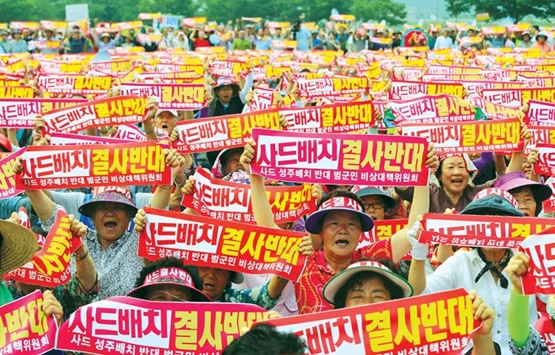Seoul said yesterday an advanced US missile defence system will be deployed in a remote southern county and will have the capacity to protect two thirds of the country against feared attacks from the North.
The plan to deploy the powerful system, which fires projectiles to smash into enemy missiles, came last week after the United States placed North Korea’s “Supreme Leader” Kim Jong-Un on its sanctions blacklist for the first time.
The move prompted objections from Russia and China, who accused Washington of flexing its military muscle in the region.
Tensions have soared since Pyongyang carried out its fourth nuclear test in January, followed by a series of missile launches that analysts say show the North is making progress toward being able to strike the US mainland.
The Terminal High Altitude Area Defense system, or THAAD, will be deployed in Seongju county about 200km southeast of Seoul, as agreed by US Secretary of Defence Ash Carter and his South Korean counterpart Han Min-Koo, according to the defence ministry in Seoul.
The deployment will be completed by the end of next year and will be able to cover up to two thirds of South Korea from North Korean missiles.
It will also protect key industrial facilities, including nuclear power plants and oil depots, the ministry added.
US military bases in the South will also be protected by the missile system, but Seoul and its surrounding areas will be left out.
This could mean the military deploying more US Patriot anti-air and missile defence systems in these areas, Yonhap news agency reported.
There have been protests about the system’s location, with residents fearing harmful economic and environmental effects.
“We hope the people and residents in Seongju...render support” for the decision, the ministry said in a statement.
But thousands took to the streets yesterday in Seongju town, carrying banners reading “We absolutely oppose THAAD deployment”, Yonhap news agency reported.
The head of the county Kim Hang-Gon and some 10 others staged a hunger strike, cut their fingers and wrote slogans in blood on banners at the yesterday’s rally.
“The THAAD deployment threatens the livelihood of the country’s 45,000 residents, 60% of whom are engaged in watermelon agriculture”, a group against the deployment said in a statement.
North Korea has threatened to take “physical action” against the planned deployment of the powerful anti-missile system.
The move has also angered Beijing and Moscow, which both see it as a US bid to boost military might in the region.
China on Friday said the move would “seriously damage” regional security in northeast Asia.
The US and South Korea began talks on deploying the THAAD system to the Korean peninsula in February after the North fired a long-range rocket.
South Korean authorities have scrambled to allay fears over possible trade retaliations from its largest trading partner China.
Finance Minister Yoo Il-Ho told the National Assembly Wednesday he believed China will separate politics from economic affairs and is not likely to hit the South with economic sanctions over missile system deployment.

South Koreans hold up red banners reading u201cWe absolutely oppose THAAD deploymentu201d, during a rally against the planned deployment of the US-built Terminal High Altitude Area Defense, THAAD, in Seongju town.


